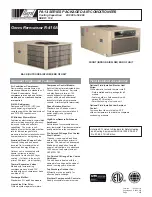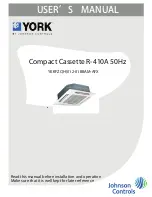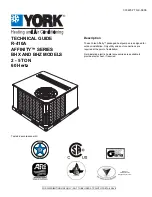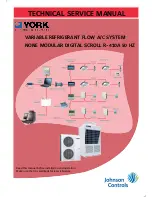
-
-
2. REFRIGERANT PIPING WORK
1) Restrictions on unit installation and use
●
Check the following points in light of the indoor unit specifications and the installation site.
●
Observe the following restrictions on unit installation and use. Improper installation can result in a compressor failure or performance degradation.
2) Determination of pipe size
●
Determine refrigerant pipe size pursuant to the following guidelines based on the
indoor unit specifications.
30m or less
20m or less
20m or less
L
H
H
Gas pipe
Liquid pipe
φ
12.7
φ
6.35
Flare
Flare
φ
12.7
φ
6.35
φ
12.7
φ
6.35
PRECAUTIONS FOR SAFETY
RWC012A029
Model 40
・
50
・
60
Designed for R410A refrigerant
●
To disconnect the appliance from the mains supply this appliance must be connected to the mains by means of a circuit breaker or a switch
(use a recognized 16A) with a contact separation of at least 3mm.
●
The appliance shall be installed in accordance with national wiring regulations.
●
This system should be applied to places as households, residences and the like. Application to inferior environment such as engineering shop
could cause equipment malfunction.
●
Ask your dealer or a specialized service provider to install the unit.
Improper installation work performed on the part of a user can result in a water leak, electric shock or fire.
●
Carry out installation work properly according to this installation manual.
Improper installation work can result in a water leak, electric shock, or fire.
●
Always turn off power before you work inside the unit such as for installation or servicing.
A failure to observe this instruction can result in an electric shock.
●
Install the unit securely onto a structure that is strong enough to sustain its weight.
Insufficient strength or improper installation can cause a fall of the unit and resultant injury.
●
Electrical installation work must be performed according to the installation manual as dedicated circuits exclusively for the air conditioning system in
compliance with the applicable “Technical standards for electrical installation” and “Indoor wiring regulations.”
A defect in power supply circuits such as insufficient capacity or improper installation can cause an electrical shock or fire.
●
Always connect between indoor and outdoor units securely with specified cables. Never use an intermediate connection or stranded wire for this purpose.
Fasten cables securely so that the terminal block may not be subject to external force working through cables.
Improper connection or fastening can cause heat generation and a resultant fire.
●
Neatly arrange the cables connecting between indoor and outdoor units so that they may not get loose, and put on the lid and/or service panel securely.
Improper installation can cause heat generation at terminal connections and a resultant fire or electric shock.
●
Use only parts supplied with the unit and approved supply parts for installation work.
A failure to use genuine parts approved by the manufacturer may result in a fall of the unit, a water leak, a fire, an electric shock, a refrigerant leak, substandard performance or a control failure.
●
If refrigerant gas leaks during installation work, ventilate the room.
Refrigerant gas, if it comes into contact with bare fire, can cause the generation of a toxic gas.
●
Use pipes, flare nuts and tools specifically designed for R410A.
The diversion of existing materials (designed for R22) can result in a unit failure as well as a serious accident such as refrigeration cycle rupture or injury.
●
In carrying out a pump-down process, stop the compressor before you detach the refrigerant pipe.
If you detach the pipe with the compressor running and the operation valves (liquid and gas sides) open, an abnormal pressure build-up will occur in the refrigeration cycle, which
can result in pipe rupture or injury.
●
In installing the unit, be sure to attach the refrigerant pipe before operating the compressor.
If you run the compressor without attaching the refrigerant pipe and with the operation valves (liquid and gas sides) open, you may incur frost bite or injury from an abrupt
refrigerant outflow. An abnormal pressure build-up may also occur in the refrigeration cycle as a result of the inhalation of air, which can result in pipe rupture or injury.
●
Tighten a flare nut with a torque wrench in a specified manner.
Over-tightening a flare nut can cause a refrigerant gas leak from breakage after years of operation and the generation of a toxic product, if refrigerant gas comes into contact with bare fire.
●
In inserting the power cable plug, make sure that no anomalies such as dust deposits, socket clogging or wobble are found in both the plug and outlet and
insert the plug fully to the roots of its blades.
Dust deposits, clogging or wobble can result in an electric shock or fire. If the outlet is loose, change it with a new one.
●
Never open the operation valves (either liquid or gas side) until refrigerant pipe installation work, an air-tightness test and an air purge are completed.
A failure to observe this instruction can result in frost bite or injury from an abrupt refrigerant outflow. If refrigerant gas leaks during installation work, immediately stop pipe
blazing and other work and ventilate the room.
●
Do not run the drain piping directly into the sewer where a toxic gas such as sulfuric gas is generated.
This will pose a risk of a toxic gas flowing back into the room. This can also cause the corrosion of the indoor unit and a resultant unit failure or refrigerant leak.
●
You must collect, bring back and shred or otherwise properly dispose of all packaging materials, expanded polystyrene, bands, vinyl bags and so on used for
the transpiration of the indoor and outdoor units after installation work.
●
In installing or transferring an air conditioning system, never allow air or other foreign matters than specified refrigerant (R410A) to get into the refrigerant cycle (piping).
If air or other foreign matters gets into the refrigerant cycle, an abnormal pressure build-up will occur, which can result in pipe rupture or injury.
●
Never modify the power cord, introduce an intermediate connection or connect it in a daisy chain.
A failure to observe this instruction can result in a fire or electric shock from improper contact, improper insulation, excessive current beyond rating, etc.
●
Never bundle, wind or modify the power cord. Do not step onto the power plug or otherwise deform it.
A failure to observe this instruction can result in heat generation or ignition.
●
Ensure that the unit is properly grounded.
Do not connect the grounding wire to a gas pipe, water pipe, lightning rod, or telephone ground wire.
If a defect is in a ground, it will become a cause of an electric shock at the time of failure or a short circuit.
●
Take sufficient care so that you may not incur injury from heat exchanger fins, pipe flares and screws during work.
●
Install drain piping according to the installation manual to ensure good drainage, and give it heat insulation to prevent condensation.
Improper installation can result in a flood of water in the room and soaked household effects.
●
When the unit is installed in a humid or damp place, the installation of an earth leakage breaker is essential.
A failure to install an earth leakage breaker can cause an electric shock.
●
When the air conditioning system is installed in a room equipped with a ventilating fan and it is used (for a cooling or dehumidifying operation) simultaneously
with the ventilating fan, the room may have a negative air pressure relative to the exterior, which can cause a reverse flow of drain water. Make sure that the room
has an opening that allows the inflow of as much air as discharged by the ventilation fan. (For example, open the door a little) Similarly, provide an adequate
opening, if a room has a negative air pressure relative to the exterior due to the effect of winds in a high-rise condominium building or the like.
●
Secure a service space for inspection and maintenance as specified in the manual.
An insufficient service space can result in a fall from the installation point and resultant injury.
●
When the outdoor unit is installed on a roof top or in an elevated position, provide permanent ladders and handrails along the access path and fences or
handrails surrounding the outdoor unit.
●
Dress the refrigerant piping with a heat insulation material to prevent condensation.
Improper heat insulation given to refrigerant piping for condensation prevention can result in leaking or dripping water soaking household effects.
●
In removing packaging materials, take sufficient care so as not to damage the contents or incur injury from such work.
●
Do not install the unit in the place where a risk of inflammable gas leaks exists.
Should gas leak and gather around the unit, it can cause the ignition of gas.
●
Do not touch the air intake and aluminum fins of the outdoor unit.
You may incur injury if you touch them.
●
Do not install the outdoor unit in a place where small animals are likely to inhabit.
If they enter the unit and touch electrical parts inside, they may cause a unit failure or fire. Please ask the customer to keep the surroundings clean.
●
Do not install the outdoor unit where its fan winds directly hit a plant etc.
Fan winds can affect adversely to the plant etc.
●
Do not operate the outdoor unit with any article placed on it.
A failure to observe this instruction can result in a fall of the article and resultant property damage or personal injury.
Check before installation work
●
Model name and power source
●
Refrigerant piping length
●
Piping, wiring and miscellaneous small parts
●
Indoor unit installation manual
Notabilia as a unit designed for R410A
●
Do not use any refrigerant other than R410A. R410A will rise to pressure about 1.6 times higher than that of a conventional refrigerant.
A cylinder containing R410A has a pink indication mark on the top.
●
A unit designed for R410A has adopted a different size indoor unit operation valve charge port and a different size check joint provided in the unit to prevent the charging of a wrong refrigerant by mistake.
The processed dimension of the flared part of a refrigerant pipe and a flare nut's parallel side measurement have also been altered to raise strength against pressure.
Accordingly, you are required to arrange dedicated R410A tools listed in the table on the right before installing or servicing this unit.
●
Do not use a charge cylinder. The use of a charge cylinder will cause the refrigerant composition to change, which results in performance degradation.
●
In charging refrigerant, always take it out from a cylinder in the liquid phase.
●
All indoor units must be models designed exclusively for R410A. Check connectable indoor unit models in a catalog, etc. (A wrong indoor unit, if connected into the system, will impair proper system operation)
◎
This installation manual deals with outdoor units and general installation specifications only. For indoor units, refer to the respective
installation manuals supplied with the units.
◎
Read this manual carefully before you set to installation work and carry it out according to the instructions contained in this manual.
●
When installing the equipment, carefully read the Precautions for safety and make sure that safety is maintained.
●
The safety items contain important information regarding safety. Be sure to follow them. The symbols used and their meanings are as follows.
WARNING
: Improper installation could result in serious accident causing death, serious injury or environmental pollution.
CAUTION
: Improper installation could result in serious accident.
●
After installation, along with confirming that no abnormalities were seen from the operation test. Explain operating methods as well as maintenance
methods to the user of this equipment, based on the owner’s manual.
●
Ask the customer to keep this manual together with the operation manual.
●
In installing the unit, you must also take thorough safety precautions to protect your person.
A failure to observe any safety instruction listed under “ Caution” can also result in a serious consequence depending on the circumstances.
Please observe all these instructions, because they include important points concerning safety.
●
The meanings of “Marks” used here are as follows:
●
Beware of danger from a dropped tool or the like in installing the unit in an elevated position.
●
When the air conditioning unit makes abnormal sounds in operation, consult with your dealer.
1. HAULAGE AND INSTALLATION
(Take particular care in carrying in or moving the unit, and always perform such an operation with two or more persons.)
②
Notabilia for installation
Intake
The height of a wall is 1200mm or less.
(
service
space
)
Intake
Outlet
Fasten with bolts
(M10-12)
Use a thicker block to
anchor deeper.
Use a long block to
extend the width.
CAUTION
When a unit is hoisted with slings for haulage, take into consideration the offset of its gravity center position.
If not properly balanced, the unit can be thrown off-balance and fall.
1) Delivery
●
Deliver the unit as close as possible to the installation site before removing it from
the packaging.
●
When you have to unpack the unit for a compelling reason before you haul it to the
installation point, hoist the unit with nylon slings or ropes and protection pads so that
you may not damage the unit.
2) Portage
●
The right hand side of the unit as viewed from the front (diffuser side) is heavier.
A person carrying the right hand side must take heed of this fact. A person carrying
the left hand side must hold with his right hand the handle provided on the front panel
of the unit and with his left hand the corner column section.
3) Selecting the installation location
Be careful of the following conditions and choose an installation place.
〇
Where air is not trapped.
〇
Where the installation fittings can be firmly installed.
〇
Where wind does not hinder the intake and outlet pipes.
〇
Out of the heat range of other heat sources.
〇
A place where stringent regulation of electric noises is applicable.
〇
Where it is safe for the drain water to be discharged.
〇
Where noise and hot air will not bother neighboring residents.
〇
Where snow will not accumulate.
〇
Where strong winds will not blow against the outlet pipe.
〇
A place where no TV set or radio receiver is placed within 5m.
(If electrical interference is caused, seek a place less likely to cause the problem)
〇
If a operation is conducted when the outdoor air temperature is -5
℃
lower, the outdoor unit should be installed
at a place where it is not influenced by natural wind.
〇
Where it is likely that the unit is subjected to strong winds, provide wind guards according to the following guidelines.
Strong winds can cause performance degradation, an accidental stop due to a rise of high pressure and a broken fan.
4) Installation space
●
Walls surrounding the unit in the four sides are not acceptable.
●
There must be a 1-meter or larger space in the above.
●
When more than one unit are installed side by side, provide a 250mm or wider interval between them as a
service space. In order to facilitate servicing of controllers, please provide a sufficient space between units
so that their top plates can be removed easily.
●
Where a danger of short-circuiting exists, install guide louvers.
●
When more than one unit are installed, provide sufficient intake space consciously so that short-circuiting may not occur.
●
Where piling snow can bury the outdoor unit, provide proper snow guards.
1.
Place the unit outlet pipe perpendicular to the wind direction.
L
3
L
2
L
4
L
1
Model 40, 50, 60
Example installation
Size
L1
L2
L3
L4
Ⅰ
Open
100
100
250
Ⅱ
280
75
80
Open
Ⅲ
280
Open
80
250
Ⅳ
180
Open
80
Open
(mm)
①
Anchor bolt fixed position
●
In installing the unit, fix the unit’s legs with bolts specified on the left.
●
The protrusion of an anchor bolt on the front side must be kept within 15 mm.
●
Securely install the unit so that it does not fall over during earthquakes or strong winds, etc.
●
Refer to the above illustrations for information regarding concrete foundations.
●
Install the unit in a level area. (With a gradient of 5 mm or less.)
Improper installation can result in a compressor failure, broken piping within the unit and abnormal noise generation.
Heavy
Wind direction
Wind direction
2.Install so the direction of the air from the blowing outlet will be
perpendicular to the direction of the wind.
5) Installation
L
H
Outdoor unit
Indoor unit
CAUTION
●
The use restrictions appearing in the table above are applicable to the standard pipe size combinations shown in the table below.
Where an existing pipe system is utilized, different one-way pipe length restrictions should apply depending on its pipe size.
For more information, please see “ 5. UTILIZATION OF EXISTING PIPING.”
Restrictions
Dimensional restrictions
Marks appearing in the drawing on the right
Main pipe length
When the outdoor unit is positioned higher,
When the outdoor unit is positioned lower,
Elevation difference between
indoor and outdoor units
Outdoor unit connected
Refrigerant piping (branch pipeL)
Indoor unit connected
Plug the end of the pipe with tape, or other
material, and fill the pipe with nitrogen gas.
Only use nitrogen gas (N
2
)
Taping
<
N
2
>
Nitrogen
Brazing
Station valve
Primary side
Secondary side
0.5MPa
Hand
Relief valve
Nitrogen
gas
Brazing must be performed under a nitrogen gas flow.
Without nitrogen gas, a large quantity of foreign matters (oxidized film) are created,
causing a critical failure from capillary tube or expansion valve clogging.
About brazing
When pipe is brazing.
3) Refrigerant pipe wall thickness and material
●
Select refrigerant pipes of the table shown on the right wall thickness and
material as specified for each pipe size.
Pipe diameter [mm]
Minimum pipe wall thickness [mm]
Pipe material*
6.35
0.8
O-type pipe
12.7
0.8
O-type pipe
NOTE
*Phosphorus deoxidized seamless copper pipe ICS 23.040.15, ICS 77.150.30
●
Select pipes having a wall thickness larger than the specified
minimum pipe thickness.
Necessary tools for the installation work
1
2
3
4
5
6
7
8
9
10
11
12
13
14
15
16
①
②
4
1
1
1
1
1
1
1
Q’ty
Accessories for outdoor unit
Gromet (Heat pump type only)
Drain elbow (Heat pump type only)
Option parts
Sealing plate
Sleeve
Inclination plate
Putty
Drain hose (extention hose)
Piping cover
(for insulation of connection piping)
Plus headed driver
Knife
Saw
Tape measure
Hammer
Spanner wrench
Torque wrench
(14.0
〜
62.0N
・
m (1.4
〜
6.2kgf
・
m) )
Hole core drill (65mm in diameter)
Wrench key (Hexagon) [ 4 m/m]
Vacuum pump
Vacuum pump adapter
(Anti-reverse flow type)
Gauge manifold
(Designed specifically for R410A)
Charge hose
(Designed specifically for R410A)
Flaring tool set
(Designed specifically for R410A)
Gas leak detector
(Designed specifically for R410A)
Gauge for projection adjustment
(Used when flare is made by using conventional flare tool)
(Designed specifically for R410A)
Pad
Never do it under any circumstances.
Always do it according to the instruction.
WARNING
Over 500mm
CAUTION
Model 40, 50, 60
Intake
Outlet
312.
5
24.
3
14.
8
288.
7
88.4
510
200
351.
6
●
Take sufficient care so that you may not incur injury from heat exchanger fins,
pipe flares and screws during work.
●
Install drain piping according to the installation manual to ensure good drainage,
and give it heat insulation to prevent condensation.
Improper installation can result in a flood of water in the room and soaked household effects.
●
When the unit is installed in a humid or damp place, the installation of an earth
leakage breaker is essential.
A failure to install an earth leakage breaker can cause an electric shock.
●
When the air conditioning system is installed in a room equipped with a ventilating
fan and it is used (for a cooling or dehumidifying operation) simultaneously
with the ventilating fan, the room may have a negative air pressure relative to the
exterior, which can cause a reverse flow of drain water. Make sure that the room
has an opening that allows the inflow of as much air as discharged by the
ventilation fan. (For example, open the door a little) Similarly, provide an adequate
opening, if a room has a negative air pressure relative to the exterior due to the effect
of winds in a high-rise condominium building or the like.
●
Secure a service space for inspection and maintenance as specified in the manual.
An insufficient service space can result in a fall from the installation point and resultant injury.
●
When the outdoor unit is installed on a roof top or in an elevated position,
provide permanent ladders and handrails along the access path and fences or
handrails surrounding the outdoor unit.
●
Dress the refrigerant piping with a heat insulation material to prevent condensation.
Improper heat insulation given to refrigerant piping for condensation prevention can result in
leaking or dripping water soaking household effects.
●
In removing packaging materials, take sufficient care so as not to damage the
contents or incur injury from such work.
●
Do not install the unit in the place where a risk of inflammable gas leaks exists.
Should gas leak and gather around the unit, it can cause the ignition of gas.
●
Do not touch the air intake and aluminum fins of the outdoor unit.
You may incur injury if you touch them.
●
Do not install the outdoor unit in a place where small animals are likely to inhabit.
If they enter the unit and touch electrical parts inside, they may cause a unit failure or fire.
Please ask the customer to keep the surroundings clean.
●
Do not install the outdoor unit where its fan winds directly hit a plant etc.
Fan winds can affect adversely to the plant etc.
●
Do not operate the outdoor unit with any article placed on it.
A failure to observe this instruction can result in a fall of the article and resultant property
damage or personal injury.
CAUTION
















































